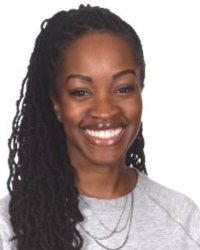Leah Jackson attended a science and engineering summer camp at Case Western Reserve University in the mid 1990s when she was a middle school student at the local girls’ school Hathaway Brown. The camp would shape Jackson’s educational and career goals—she went on to study Industrial Engineering at Northwestern University, followed by a 12-year career at Johnson Controls before returning to Hathaway Brown to serve as the founding director of its IDEA Lab. Perhaps just as importantly, the CWRU camp shaped the possibilities Jackson saw for herself in a field with few women and even fewer people of color.
This summer, Leah will come full circle when she returns to CWRU to serve as the inaugural director for the university’s new think[STEM] day camp, a two-week summer camp for local students entering 7th through 9th grades. Learn more about Jackson:
Tell us about the broad plans for think[STEM].
We’re really thinking about how to make the field of engineering fully accessible to the students while finding creative ways to also make the camp academic and tying the hands-on experiences to direct engineering concepts. My hope is that as the campers matriculate, the engineering concepts will feel familiar to them based on their exposure through the camp.
What made your CWRU camp experience as a young person so formative?
It really was my introduction into what engineering would look like in formal education. But also, what stuck with me was that the camp had students who weren’t from my school. So I was meeting new people. And I was meeting other black and brown kids, which was not my experience at school. It was the first time that I was in a classroom full of kids who looked like me and with teachers who looked like me. So once I got over the fact that I was essentially going to school in the summer, I was able to process all the other benefits. I really loved it and every summer I looked forward to going. We had a cohort of students who came back every year and some of them became my close friends.
How has that experience informed the structure of think[STEM]?
We will break up our curriculum and content into the various engineering disciplines with specific activities for each one and then I’d like to have a culminating activity where the students also see the crossover between the disciplines. In the real world, most people aren’t just architectural engineers or aerospace engineers—they have to learn multiple skill sets and transfer those across the board. There are so many women I went to college with who studied engineering and who are now lawyers, patent attorneys or physicians. I hope that students see that, yes, you can go into engineering as a career, or this could be something that launches you into something related. Engineering, in general, is so valuable because it teaches you to problem solve.
What are some activities that young people can do on their own to develop their engineering and problem solving skills?
I love anything that requires children to follow step-by-step instructions. So anything that involves taking inventory of pieces and parts and making sure that you have your proper tooling to do the task. Then, it’s just a matter of taking your time, following the instructions, and maybe putting something together or maybe failing. There are plenty of times when you start a project and then realize that you haven’t done something right. So you have to take it apart and do it again until you get it right. That’s how we learn. When I was a child, my mother would bring home things for me to assemble, and my father was a contractor, so I was always exposed to tools and making things. Those were such valuable experiences.


